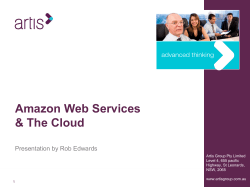
Enabling Internet of Things with Cloud and Big Data Networking
International Summer and Winter Term on Enabling Internet of Things with Cloud and Big Data Networking Organized by: IIT Kharagpur Co-sponsored by: ITRA 25th May - 7th June, 2015 Faculty International Faculty: 1. Prof. Dharma Agrawal Department of EECS, Chartered Fellow-NAI Fellow IEEE, ACM, AAAS, WIF, OBR Distinguished Professor University of Cincinnati 2. Prof. Bharat Bhargava, Fellow IEEE Department of Computer Science Purdue University National Faculty: 1. Prof. Bhabani P. Sinha, Fellow IEEE Advanced Computing and Microelectronics Unit, Indian Statistical Institute (ISI) Kolkata 2. Prof. Nabanita Das, Senior Member IEEE Advanced Computing and Microelectronics Unit, Indian Statistical Institute (ISI) Kolkata 3. Prof. Sudip Misra, Senior Member IEEE School of Information Technology, Indian Institute of Technology Kharagpur Overview Cloud computing and the big-data analytics are the two new technologies that are evolving across the globe. IT organizations are moving towards the concept of seamless computing, and real-time processing of data with high degree of resource scalability. Moreover, cloud technology is continuously improving in security and data integration techniques. Business organizations are more concerned with the growing scope of data analytics, rather than selective storing of data from diverse resources. Thus, big-data and cloud technologies go hand-in-hand and as a result, most of the organizations are inclining towards cloud delivery models, in addition with the support of big-data analytics, especially for mission-critical workloads. The collaboration of these two technologies enable the scope of another emerging technology – the Internetof-Things (IoT). With the help of cloud and big-data networking, today it is possible to envision pervasive connectivity, storage, and computation, which, in turn, gives rise to different IoT solutions from environmental sensing to public safety. IoT-based applications such as innovative shopping system, infrastructure management in both urban and rural areas, remote health monitoring and emergency notification systems, and transportation systems, are gradually realizing the long-awaited dream of smart-cities. Hence, proper focus on Internet-of-Things, with the assistance of cloud and big-data technology, is of utmost importance in today's modern world. Details Content of the course S. No. Content 1 2 3 4 5 6 7 8 9 10 11 12 14 15 Introduction and Application of Wireless Sensor Network (WSN) Medium Access in WSN Protocols of WSN Basics Introduction of different Sensors Components of WSN (Real Test Bed) Working Procedure of WSN (Real Test Bed) Description and Prototype of WSN Fundamental Cloud Computing Terminology and Concepts Basics of Virtualization Specific Characteristics that Define a Cloud Understanding Elasticity, Resiliency, On-Demand and Measured Usage Benefits, Challenges and Risks of Contemporary Cloud Computing Platforms and Cloud Services Software as a Service (SaaS), Platform as a Service (PaaS) and Infrastructure as a Service (IaaS) Cloud Delivery Models Public Cloud, Private Cloud, Hybrid Cloud and Community Cloud Deployment Models Service Level Agreements (SLAs) for Cloud-based IT Resources 16 17 18 19 20 Introduction of Big Data Characteristics, Architecture, and Application of Big Data History, Introduction, and Applications of Internet of Things (IoT) Addressing in IoT Convergence of Cloud and Big Data in IoT 13
© Copyright 2025










